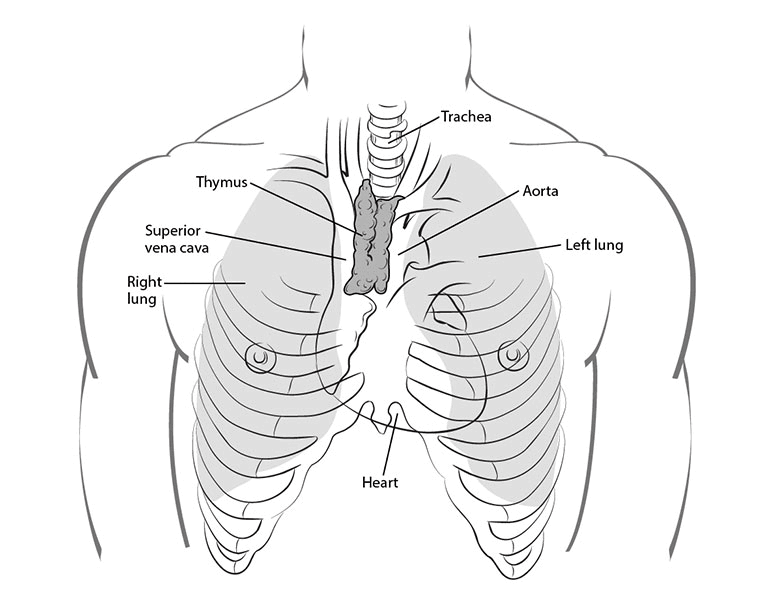What is TNET Cancer?
Thymic Neuroendocrine Tumor Cancer
Click on Underlined Words for Link
What Is Thymus Cancer?
Cancer that starts in the thymus gland is called thymus cancer. It starts when cells in the thymus gland grow out of control and crowd out normal cells. Thymus cancers are rare.
The thymus
The thymus is a small organ just behind the breast bone (sternum) in the front part of the chest. The thymus is in a part of the chest called the mediastinum, the space between the lungs that also contains the heart, part of the aorta, the esophagus (the tube that connects the mouth to the stomach), part of the trachea (windpipe), and many lymph nodes. The thymus sits just in front of and above the heart.

The thymus has 2 halves, called lobes. It has an irregular shape. There are a lot of small bumps called lobules on its surface. The thymus has 3 main layers:
- The medulla is the inner part of the thymus.
- The cortex is the outer layer that surrounds the medulla.
- The capsule is the thin covering over the outside of the thymus.
The thymus reaches its biggest size during puberty. Then it shrinks during adulthood, and most of it is replaced by fat tissue.
The thymus is an important part of the body’s immune system. Starting very early in life, the thymus makes immune cells called T lymphocytes (also known as T cells) and helps them to mature. T lymphocytes then travel to lymph nodes (small, bean-shaped organs that filter lymph fluid) throughout the body, where they help fight infections.
The thymus is made of different types of cells. Each kind can develop into a different type of cancer:
- Epithelial cells give the thymus its structure and shape. Thymomas and thymic carcinomas develop from these cells.
- Lymphocytes make up most of the rest of the thymus. Whether in the thymus or in other parts of the body, these immune system cells can develop into cancers called Hodgkin lymphoma and non-Hodgkin lymphoma.
-
Kulchitsky cells, or neuroendocrine cells, are much less common cells that normally release certain hormones. These cells can give rise to thymic neuroendocrine tumors (TNETs), which are described below.
Thymic neuroendocrine tumors (TNETs)
Thymic neuroendocrine tumors (TNETs) are rare tumors that can form from neuroendocrine cells in the thymus. TNETs may be linked with other conditions that affect the endocrine system, like Cushing syndrome and MEN1 syndrome.
These tumors are rare, so not a lot is known about them. But they are usually treated like similar NETs that start in other parts of the body.
There are several types of TNETs:
- Typical carcinoid tumors (TCs): These are low-grade (slow-growing) tumors that rarely spread.
- Atypical carcinoid tumors (ACs): These tumors tend to grow a little faster than typical carcinoids and are somewhat more likely to spread to other organs.
- Large cell neuroendocrine carcinoma (LCNEC). This is a high-grade cancer that tends to grow quickly and is likely to spread to other parts of the body.
- Small cell carcinoma. This is a high-grade cancer, with cells that look like small cell cancers in other parts of the body (such as small cell lung cancer). These cancers tend to grow quickly and to spread to other parts of the body.
